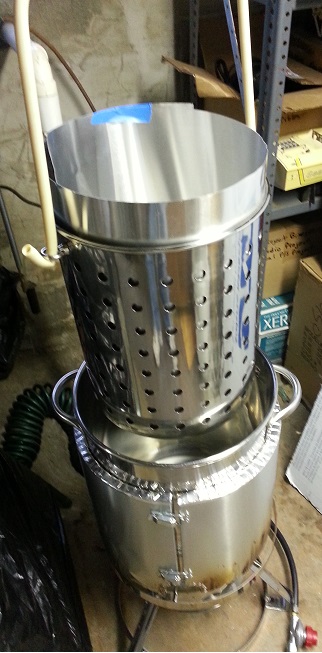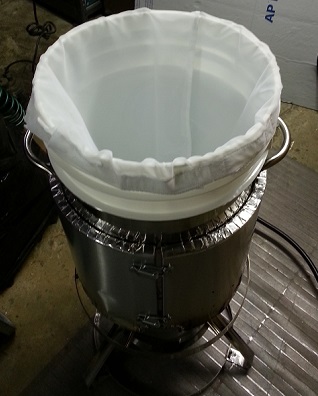I've done a few BIAB brews using Beersmith, and I'm not wholly impressed with my results. I'm studying up on the way mash time and temp impacts the end beer to address that part, but I need to be able to better manage the process as well. I think my process was negatively impacting the mash.
I have a 30 qt pot that based on actual measurement is more like 28 (7 gal). For full batch mashing this is too small, but a bigger pot is not an option. I'm too 'invested' in this one, plus I think my modified process will resolve this.
The last 2 brews I did were with 24 qts of water in the pot which leaves enough room for a good grain bill. After the mash is over I lift the bag out (and into the 'steamer basket' that came with the pot - more on that later) and do 2 batch sparges for about 2 more gallons and leave it to drain while I start the boil. I've hit my preboil volume and OG fairly close this way so far.
I'd like to use Beersmith to accurately build the full recipe and brew process, but as soon as I click BIAB it sets the initial water to 28+ qts, and won't let you edit it. What I'm wondering is if it's possible to use a standard single infusion process in Beersmith and adjust my water numbers to target my desired 24 qts. I know that BIAB is supposed to be full volume no sparge with results that can compete with regular AG, but I really think I can make my process very efficient without loosing any benefits of BIAB.
The hardware I'm looking to use in future brews would be a hanging basket that fits the pot as closely as possible to minimize dead space around it, and holes only in the bottom. The steamer basket I have now is way too small to use in the pot to start so I have to lift the bag out, then squeeze it into the basket along with flexible plastic cutting boards around the bag to block the holes in the sides of the basket. With them open the water just runs off the top. This works, but it's messy, hot, and no fun.
With a close fit basket, I drop that in the pot during the initial heat to strike temp, then add BIAB bag and grains. My bag hook doubles as a grain bucket support so I can pour the grain with 1 hand while I stir it in with the other. No lumps!
When the mash is over I hoist the bag & basket up, fire up the boil, batch sparge with 1 gallon then a second. I'd leave it hanging as long as I can while I bring up the boil, and then it's done without squeezing. Anything that continues to drain out by the last 15 min of the boil would be a "late addition".
Anyone else doing a similar process, and are you using Beersmith and NOT BIAB mash? I've played with the single infusion mash, but not enough to know if I'm on the right track with it.
Any ideas would be appreciated!
John
I have a 30 qt pot that based on actual measurement is more like 28 (7 gal). For full batch mashing this is too small, but a bigger pot is not an option. I'm too 'invested' in this one, plus I think my modified process will resolve this.
The last 2 brews I did were with 24 qts of water in the pot which leaves enough room for a good grain bill. After the mash is over I lift the bag out (and into the 'steamer basket' that came with the pot - more on that later) and do 2 batch sparges for about 2 more gallons and leave it to drain while I start the boil. I've hit my preboil volume and OG fairly close this way so far.
I'd like to use Beersmith to accurately build the full recipe and brew process, but as soon as I click BIAB it sets the initial water to 28+ qts, and won't let you edit it. What I'm wondering is if it's possible to use a standard single infusion process in Beersmith and adjust my water numbers to target my desired 24 qts. I know that BIAB is supposed to be full volume no sparge with results that can compete with regular AG, but I really think I can make my process very efficient without loosing any benefits of BIAB.
The hardware I'm looking to use in future brews would be a hanging basket that fits the pot as closely as possible to minimize dead space around it, and holes only in the bottom. The steamer basket I have now is way too small to use in the pot to start so I have to lift the bag out, then squeeze it into the basket along with flexible plastic cutting boards around the bag to block the holes in the sides of the basket. With them open the water just runs off the top. This works, but it's messy, hot, and no fun.
With a close fit basket, I drop that in the pot during the initial heat to strike temp, then add BIAB bag and grains. My bag hook doubles as a grain bucket support so I can pour the grain with 1 hand while I stir it in with the other. No lumps!
When the mash is over I hoist the bag & basket up, fire up the boil, batch sparge with 1 gallon then a second. I'd leave it hanging as long as I can while I bring up the boil, and then it's done without squeezing. Anything that continues to drain out by the last 15 min of the boil would be a "late addition".
Anyone else doing a similar process, and are you using Beersmith and NOT BIAB mash? I've played with the single infusion mash, but not enough to know if I'm on the right track with it.
Any ideas would be appreciated!
John






